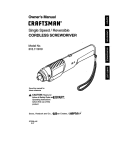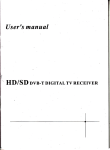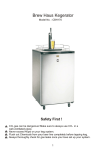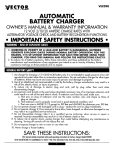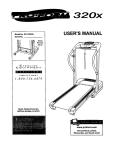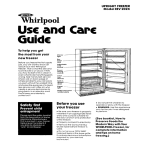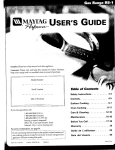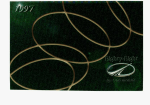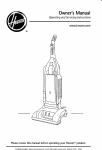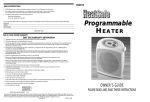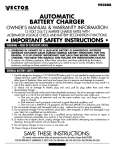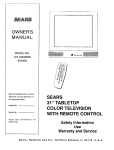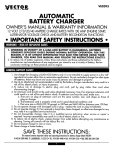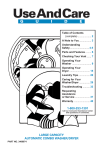Download Sears 608.718571 User's Manual
Transcript
SEARS OWNERS MANUAL MODEL NO. 608.718571 1 A P i 2 AMP 12 VOLT AUTOMATIC BATTERY CHARGER CAUTION: Read Rules for Safe Operation and Instructions Carefully FOR 12 VOLT Save These Instructions Sears, Roebuck and Co., Chicago, BATTERIES Operation Repair Parts Illinois 60684 U.S.A. FORM_-135726 THIS MANUALWILL HELPYOUUSEYOURSEARSBATTERYCHARGER SAFELYAND EFFICIENTLY WARNING: WORKINGWITH ORNEARLEADACID BATTERIESIS DANGEROUS.BATTERIESCONTAINSULFURICACIDAND PRODUCE EXPLOSIVEGASES.A BATTERYEXPLOSIONCOULDRESULTIN LOSSOF EYESIGHTOR SERIOUS BURNS.PLEASEREADTHIS ENTIREMANUALCAREFULLYBEFOREUSINGYOURCHARGER. i ...................................... ':' FULL 12 MONTHWARRANTY,:"................... j f, withintwelvemonthsfromdateof purchase,this batterychargerfailsdue to a defectin materialsor workmanship, i simplyreturnit tothe nearestSearsstorethroughout theUnitedStates,andSearswillrepairor replaceit, freeof charge. Thiswarrantygivesyou specificlegalrights,and you may alsohaveotherrightswhichvaryfromstateto state. .'.. i I ! Y L_ Tower, Chicago, Sears,Roebuckand Company,Dept. 698/731A, Sears IL 60684 I .! IMPORTANTSAFETY INSTRUCTIONS SAVETHESE INSTRUCTIONS 1. 2. 3. 4. 5. 6. 7. 8. 9. This manual contains important safety and operating instructionsapplicable to the use of battery charger model number 608.718571. Do not exposecharger to rain or snow. Useof an attachmentnot recommendedor sold by the batterycharger manufacturermay result in a risk of fire, electric shock, or injury of persons. To reducerisk of damageto electric plug and cord, pull by plug rather than cord when disconnectingcharger. An extensioncord should not be used unless absolutelynecessary.Use of improperextensioncord could result in a risk of fire or electric shock. If extensioncord must be used, make sure: a. That pins on plug of extensioncord are the same number, size, and shapeof those of plug on charger; b. That extensioncord is properly wired and in good electrical condition; and c. That wire in cord is proper size as follows: Minimum recommendedAWGwire size for various length extensioncords usedwith this charger: Length of Cord, Feet 25 50 100 150 AWGSize 18 18 16 14 Do not operatecharger with damagedcord or plug. Replacethem immediately. Donot operatechargerif it hasreceiveda sharp blow, beendropped, or otherwisedamagedin any way; take it to the nearestSears Service Center. Do not disassemblecharger; take it to the nearest SearsService Centerwhen serviceor repair is required. Incorrect reassembly may result in a risk of electric shock or fire. To reduce risk of electric shock, unplug charger from outlet beforeattempting any maintenanceor cleaning. Turning off controls will not reducethis risk. PERSONALPRECAUTIONS 1. 2. 3. 4. 5. 6. 7. 8. 9. Removepersonal metal items such as rings, bracelets, necklaces,and watches when working with a lead-acid battery. A lead-acid battery can produce a short circuit current high enough to weld jewelry to metal, causing a severeburn. Someoneshould be within range of your voice or close enough to come to your aid when you work near a leadacid battery. Haveplenty of fresh water and soap nearbyin case battery acid contacts skin, clothing or eyes. Wear complete eye protection and clothing protection. Avoid touching eyes while working near battery. Clothing will be damagedif it comesin contact with battery acid. If batteryacid contactsskin or clothing, wash immediately with soapand water. If acid contactseyes, immediately flood eyes with running cold water for at least 15 minutes and get medical attention immediately. NEVERsmokeor allowa spark or flame in vicinity of battery or engine. Be extra cautiousto reduce risk of dropping a metal tool onto battery. It might spark or short-circuit battery or other electrical parts that may cause explosion. Use chargerfor charging a LEAD-ACIDbatteryonly. It is 10. not intended to supply power to a low-voltageelectrical system other than in an automotiveapplication. Do not use battery charger for charging dry-cell batteriesthat are commonly used with homeappliances. These batteries may burst and causeinjury to personsand damage to property. DONOTATTEMPTTOCHARGE A FROZENBATTERY... If the case is not cracked, removethe batteryto a warm area until the ice has completely melted before attempting to charge. WARNING -1. 2. RISK OF EXPLOSIVE GASES. WORKINGIN VICINITY OF A LEAD-ACIDBATTERYIS DANGEROUS. BATTERIES GENERATE EXPLOSIVE GASESDURINGNORMALBATTERYOPERATION.FOR THIS REASON,IT IS OF UTMOSTIMPORTANCE THAT EACHTIME BEFORE USINGYOURCHARGER, YOUREAD THIS MANUALAND FOLLOWTHE INSTRUCTIONS EXACTLY. To reduce risk of battery explosion,follow these instructions and those published by battery manufacturerand manufacturer of any equipment you intend to use in vicinity of battery. Reviewcautionarymarking on these products and on engine. GROUNDINGANDAC POWERCORDCONNECTIONINSTRUCTIONS Charger should be grounded to reduce risk of electric shock. Chargeris equipped with an electric cord having an equipmentgrounding conductor and a grounding plug. The plug must be plugged into an outlet that is properly installed and grounded in accordance with all local codes and ordinances. GROUNDING GROUNDED ADAPTER OUTLET DANGER-- Never alter AC cord or plug provided-if it will not fit outlet, have proper outlet installed by a qualified electrician. Improper connectioncan result in a risk of an electric shock. This battery charger is for use on a nominal 120 volt circuit and has a grounding plug that looks like the plug illustrated in sketch A in Figure 1. A temporary adapter, which looks like the adapter illustratedin sketches B and C, may be used to connect this plug to a two-pole receptacleas shown in sketch B if a properly grounded outlet is not available. The temporary adapter should be used only until a properly grounded outlet can be installed by a qualified electrician. METHODS OUTLET COVER BOX OF GROUNDED _ DAPTER "-'_--"_ (c) GROUNDING MEANS (B) Fig. 1 DANGER-- Before using adapter as illustrated, be sure that center screw of outlet plate is grounded. The green colored rigid ear or lug extending from adapter must be connected to a properly grounded outlet - make certain it is grounded. If necessary, replace original outlet cover plate screw with a longer screw that will secure adapter ear or lug to outlet cover plate and make ground connection to grounded outlet. PREPARINGTO CHARGE 1. 2. 3. 4. If necessary to remove battery from vehicle to charge, always remove grounded terminal from battery first. Make sure all accessories in the vehicle are off, so as not to cause an arc. Be sure area around battery is well ventilated while battery is being charged. Gascan be forcefully blown away by using a piece of cardboardor other non-metallicmaterial as a fan. Clean battery terminals. Be careful to keep corrosion from coming in contact with eyes. Keep the battery terminals clean and tight. Use Searsterminal protectors to prevent corrosion. (Available through most Sears stores or catalog.) If battery has removablefiller vents, check periodically to make sure battery electrolyte (liquid) covers the plates. If liquid is down, add only DISTILLEDWATERto bring level up. This also helps purge excessive gas from the cells. NOTE:DONOTOVERFILL(OVERFILLINGCOULDRESULT IN DAMAGE). For a battery without cell caps, carefully 5. 6. follow manufacturer's charging instructions. Study all battery manufacturer's specific precautionssuch as removing or not removing cell caps while charging, and recommendedrates of charge. Determine voltage of battery by referring to car owner's manual. This charger can be used to charge only 12 volt batteries. CHARGERLOCATION 1. 2. 3. 4. 5. Locate charger as far away from battery as the DC cables permit. Never place charger directly above battery being charged; gases from battery will corrode and damagecharger. Never allow battery acid to drip on charger when reading specific gravity or filling battery. Do not operate charger in a closed-in area or restrict ventilation in any way. Do not set battery on top of charger. OPERATINGINSTRUCTIONS Your new Sears automatic battery charger is a home type automotive charger designed to charge 12 V batteries of either conventional or maintenancefree construction. The rated output current is 10 amperes for large batteries and 2 amperes for smaller batteries such as on motorcycles, garden tractors, etc. When operating your charger carefully follow the steps under CHARGINGBATTERYIN VEHICLEor CHARGINGBATTERYOUT OF VEHICLE. After completion of Step 7, the meter on the charger will indicate the amount of DCamperesof charge being delivered to the battery. This charging rate will taper off as the battery comes up to full charge. In automatic chargers the voltage is limited to a preset levelto prevent overcharging. The charge rate drops to a very low pulsating rate to maintain battery charge level. If current is drawn from the battery as in some type of standby operation, the charger will automatically come on to compensate. DEEPCYCLECHARGING-- [To charge deep cycle batteries, you must monitor the charging to insure the size battery you are charging permits the voltage to increase to the preset trickle trip point of the control circuit.] If the battery becomes very warm (_ 125°F) or appears to be bubbling freely charging should be stopped. DC CONNECTIONPRECAUTIONS . . Connectand disconnect DC output clips only after removing AC cord from electric outlet. Never allow clips to touch each other. Attach clip to battery post and twist or rock back and forth several times to make a good connection. This helps to keep clip from slipping off terminal and helps to reduce risks of sparking. Attach grounding clip to engine block or unpainted car frame, away from gas line and carburetor. CHARGINGBATTERYIN VEHICLE FOLLOWTHESE STEPSWHEN BATTERYIS INSTALLEDIN VEHICLE. A SPARK NEAR BATTERYMAY CAUSE BATTERY EXPLOSION.TO REDUCERISK OF A SPARKNEAR BATTERY: 1. Position AC and DC cords to reduce risk of damage by hood, door or moving engine parts. 2. Stay clear of fan blades, belts, pulleys and other parts that can cause injury. 3. 4. 5. 6. k ¸ 7. Check polarity of battery posts. POSITIVE(POS, P, +) battery post usually has a larger diameter than NEGATIVE (NEG, N, -) post. Determinewhich post of battery is grounded (connected) to the chassis, tf negative post is grounded to chassis (as in most vehicles), see item 5. If positive post is grounded to chassis, see item 6. For common negative-grounded vehicle, connect POS!TIVE (RED)clip from battery charger to POSITIVE(POS,P, +) ungrounded post of battery. Connect NEGATIVE (BLACK) clip to vehicle chassis or engine block away from battery. Do not connect clip to carburetor, fuel lines, or sheet-metal body parts. Connect to a heavy gage metal part of the frame or engine block. For positive-groundedvehicle, connect NEGATIVE(BLACK) clip from battery charger to NEGATIVE(NEG, N, -) ungrounded post of battery. Connect POSITIVE(RED) clip to vehicle chassis or engine block away from battery. Do not connect clip to carburetor, fuel lines, or sheet-metal body parts. Connectto a heavy gage metal part of the frame or engine block. Set control to 10 amp or 2 amp. ONLY - After completing steps 1 through 6, plug the power cord of the charger into grounded 120 volts, 60 Hz outlet. PROPERDISCONNECTPROCEDURE 1. 2. 3. circuit (item 7 on your parts list), the other is built on the transformer. The first will operatewhen a short circuit, reverse connections, or too long engine cranking overloads the charger. The protector will open with a click sound and reclose in a few seconds. The second protector will operate when a prolonged overloaddue to a defective battery or other excessive load causes the transformer to overheat. It is a one time device and once it functions the transformer must be replaced. TIME REQUIREDTO CHARGE 1. 2. POSSIBLECHARGINGPROBLEMS 1. ALWAYS unplug the charger power cord before doing anything else. Then disconnect the grounded clamp from the engine block or framework. Finally, disconnect the remaining clamp from the battery terminal. CHARGINGBATTERYOUT OF VEHICLE FOLLOWTHESE STEPSWHEN BATTERYIS OUTSIDEVEHICLE. A SPARK NEAR THE BATTERYMAY CAUSE BATTERY EXPLOSION.TO REDUCERISK OFA SPARKNEAR BATTERY: 1. Check polarity of battery posts. POSITIVE(POS, P, +) battery post usually has a larger diameter than NEGATIVE (NEG, N, -) post. 2. Attach at least a 24-inch-long 6-gauge (AWG) insulated battery cable to NEGATIVE(NEG, N, -) battery post. (This can be a standard automobile battery cable available through your Sears Auto Center or other auto parts store.) 3. Connect POSITIVE(RED) charger clip to POSITIVE:(POS, P, +) post of battery. 4. Positionyourself and free end of cable as far away from the battery as possible - then connect NEGATIVE(BLACK) charger clip to free end of cable. 5. Do not face battery when making final connection. Set control to desired current 10 or 2 amp. 6. 7. ONLY- After completing steps 1 through 5, insert power cord to a grounded outlet of 120 volts, 60 Hz. A marine (boat) battery must be removed and charged on shore. To charge it on board requires equipment specially designed for marine use. PROPERDISCONNECTPROCEDURE 1. 2. 3. ALWAYS unplug the charger power cord before doing anything else. Then disconnect the negative (black) lead from the end of the 24 inch cable. Finally, disconnect positive (red) lead from battery post. CHARGEROVERLOADPROTECTION Your Sears battery charger is protected from power overloadby two automatic heat sensing switches. One is in the DC output A battery is fully charged when: a. A hydrometer reading of the electrolyte liquid reaches 1.250 or above(all cells should haveapproximately the same reading). b. The charger rate drops to a very low pulsating rate to maintain battery charge level. (3-5) hours for most 12 volt batteriesor (5-8) hoursfor smaller 12 volt batteries at 2 amperes. OVERCHARGING OFBATTERIESSHOULDBE AVOIDEDAS MUCH AS POSSIBLE. Overcharging causes excessive gassing, loss of water, and eventual damage to the battery. Charging should be stopped if battery becomesvery warm (over about 125 Degrees Fahrenheit) or appears to be bubbling freely. 2. Meter needle swings to far right side of meter: Your new battery charger has been equipped with an automatic reset circuit breaker. This protects the charger from temporaryoverloadconditions. A severelydischarged battery, a battery with shorted cells, or reversed charger connections at the battery will cause this protective device to operate. Under these overload conclitions, the circuit breaker will open, and when cooled down will reset automatically. This cycling processcan be identified by a clicking sound made during the opening and closing of the circuit breaker. a. Check for reverse polarity connections. b. If battery is severely discharged, charge meter needle will start to cycle up and down, and will stabilize after 15 to 20 minutes. c. Battery may have one or more shorted cells. Cycling will start immediatelyand continue indefinitely. If cycling has not stopped as outlined in (b), disconnect charger (AC power cord first) and have battery tested. No meter reading: a. Check connections to battery and engine block or car frame. Be sure polarity is correct (red clip to positive). "Rock" the clips to bite through any dirt or corrosion. If in a vehicle, be sure terminals on battery are clean and tight. b. Check AC outlet or extension cord connections. c. One or more cells may be shorted. Thermal switch in charger may cycle (click on and off). MAINTENANCEAND CLEANING Very little maintenance is required. As with any appliance or tool, a few commonsense rules will prolong the life of your battery charger. ALWAYS BE SURECHARGERIS UNPLUGGEDBEFOREDOING ANY MAINTENANCEOR CLEANING. 1. Store in a clean, dry place. 2. Coil up cords when not in use. 3. Clean case and cords with a dry or slightly damp cloth. 4. Cleanany corrosion from clips with a solution of water and baking soda. 5. Examine cords periodically for cracking or other damage. Have them replaced if necessary. SERVICE WARNING: TO REDUCETHE A parts list, assembly drawing, etc. are provided for use by service personnel. -- RISK OF ELECTRIC SHOCK, DO NOT PERFORMANY SERVICINGOTHERTHAN THAT CONTAINED IN THE OPERATING INSTRUCTIONS UNLESSYOU AREQUALIFIEDTO DO SO. I? le P.o. CAR(] 3UHPER OETAIL CONNECTION REAR WHT #4 _L_ VIEW OF TRANSFORNER _]10Ht _#1_ METER 2 CONNECTIONS BACK VIEW OUTPUT \ RED & REPAIR PARTS 10/2Amp 12 Volt Battery Charger MODELNO. 608.718571 AMP METER i INPUT 120 V 60 HZ I0_ -F Key 1 2 3 4 5 6 7 8 9 10 11 12 13 14 15 16 17 18 19 2A I LIC_Ij SWITCH BL BROWN Part Number SD-t22262 SD-30-122599 SA-I-128431 SB-135724 ST-91340 SA-1490528 SA-2-!33344 ** SA-l-1320517 SA-83986 SA-t05350 SA-105598 SB-1-134371B SA-128299 *STD-551210 *STD-541110 *STD-510605 SA-135726 SA-1591008 * Description Cover Case Handle Decal Transformer Meter Thermal Switch Rivet Input Cord Output Cord Strain Relief Strain Relief P,C. Assembly Warning Label No. 10 Lockwasher (3) No. 10-32 Hex Nut (3) No. 6-32 x 1/2 Screw Owner'sManual& PartsList Switch 10-32 x 3/8 Screw **For Replacement Use: *STD-511103 No. 10-32 x 3/8 Screw(4) *STD-541210 No. 10 Lockwasher (2) *STD-541110 No. 10-32 Hex Nut (4) *Standard Hardware - may be purchased locally. HOW TO USE YOUR 1. This charger BATTERY CHARGER is for 12 volt batteries. 2. Make sure battery 3. Do not smoke, strike a match or cause any sparks in the vicinity the battery. 4. For a negative a, b. is in a well-ventilated grounded area. of vehicle: Connect RED (+) clip to (+) terminal on battery. Connect BLACK (-) clip to engine block away from battery. Do not connect to battery terminal. (A spark near the battery may cause battery explosion.) IN VEHICLE When charging battery out of vehicle: 1) Connect a 24" minimum length of No. 6 gauge insulated battery cable to negative (-) battery terminal. 2) Connect RED (+) clip to (+) terminal. 3) Connect BLACK (-) clip to jumper cable away from battery. Do not connect to battery terminal.-(A spark near the battery may cause battery explosion.) 5. Select 6. Plug the AC (input cord) into a grounded 7, Charger a) b) c) desired charging OUTOF VEHICLE amperage. outlet. Disconnect Disconnect AC (input cord). Remove BLACK(-) clip. Remove RED (+) clip. S _AIRS C 10 AMP / 2 AMP 12 VOLT AUTOMATIC BATTERY CHARGER Now that you have purchased need ever exist for repair parts Sears Service Center and most Be sure to provide all pertinent OWNERS MANUAL MODEL NO. 608.718571 The model number the front panel. of your battery charger will WHEN ORDERING REPAIR PARTS, ALWAYS LOWING INFORMATION: ° PART NUMBER ° PART DESCRIPTION ° MODEL NUMBER " NAME OF ITEM All parts listed may be ordered and most Sears stores. HOWTO ORDER REPAIRPARTS your battery charger, should a or service, simply contact any Sears, Roebuck and Co. stores. facts when you call or visit. be found on GIVE THE FOL- from any Sears Service Center If the parts you need are not stocked locally, your order will be electronically transmitted to a Sears Repair Parts Distribution Center for handling. Sears, Roebuckand Company,Sears Tower, Chicago,IL 60684 A-135726 189






